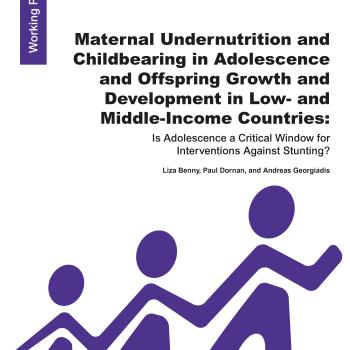Publication Information

Maternal undernutrition and adolescent childbearing are prevalent in low- and middle-income countries and have harmful consequences for children. However, less is known on whether these implications persist throughout the offspring’s life course. Moreover, although adult nutritional status has been suggested to largely reflect conditions during the period from conception to 2 years old (“the first 1,000 days”), others have argued that adolescence is an equally important period for nutrition. This is not well established, however, and there is less evidence on the relative importance of conditions during the first 1,000 days of a girl’s life, versus during adolescence, for her nutritional status during pregnancy.
This working paper addresses these gaps through two interrelated investigations. First, we document associations of mothers’ stunting and adolescent childbearing with their children’s developmental outcomes from infancy through early adolescence, using data on a cohort of children and their mothers from Ethiopia, India, Peru, and Vietnam. Second, in order to infer whether maternal adult undernutrition may reflect undernutrition during adolescence, we use data from another cohort of girls in each of these countries who were surveyed throughout adolescence to estimate the extent of catch-up growth during adolescence.
The results suggest that maternal stunting and adolescent childbearing are both associated with offspring stunting at infancy, that the association between the mother’s and offspring’s stunting persists through the offspring’s early adolescence, and that the two maternal outcomes are not systematically associated with offspring cognitive achievement.
Taking account of many variables which could affect children's stunting, we find that being born to a stunted adolescent mother was associated with a 15 percentage point increased chance of child being stunted, compared with being born to a non-stunted older mother. We also find that among adolescent girls with height below the WHO standard at 12 years old, on average, 40 per cent of the height deficit was recovered by age 19. As most of this change is likely to have occurred during early adolescence (in this data 12-15 years old), this may be a particularly promising time for interventions to take place.
Overall, the findings reinforce concerns over the long-term implications of mother’s nutritional circumstances for their children’s healthy growth and suggest interventions that aim to delay childbearing and promote catch-up growth in early adolescence, has promise in breaking the intergenerational cycle of stunting.

Maternal undernutrition and adolescent childbearing are prevalent in low- and middle-income countries and have harmful consequences for children. However, less is known on whether these implications persist throughout the offspring’s life course. Moreover, although adult nutritional status has been suggested to largely reflect conditions during the period from conception to 2 years old (“the first 1,000 days”), others have argued that adolescence is an equally important period for nutrition. This is not well established, however, and there is less evidence on the relative importance of conditions during the first 1,000 days of a girl’s life, versus during adolescence, for her nutritional status during pregnancy.
This working paper addresses these gaps through two interrelated investigations. First, we document associations of mothers’ stunting and adolescent childbearing with their children’s developmental outcomes from infancy through early adolescence, using data on a cohort of children and their mothers from Ethiopia, India, Peru, and Vietnam. Second, in order to infer whether maternal adult undernutrition may reflect undernutrition during adolescence, we use data from another cohort of girls in each of these countries who were surveyed throughout adolescence to estimate the extent of catch-up growth during adolescence.
The results suggest that maternal stunting and adolescent childbearing are both associated with offspring stunting at infancy, that the association between the mother’s and offspring’s stunting persists through the offspring’s early adolescence, and that the two maternal outcomes are not systematically associated with offspring cognitive achievement.
Taking account of many variables which could affect children's stunting, we find that being born to a stunted adolescent mother was associated with a 15 percentage point increased chance of child being stunted, compared with being born to a non-stunted older mother. We also find that among adolescent girls with height below the WHO standard at 12 years old, on average, 40 per cent of the height deficit was recovered by age 19. As most of this change is likely to have occurred during early adolescence (in this data 12-15 years old), this may be a particularly promising time for interventions to take place.
Overall, the findings reinforce concerns over the long-term implications of mother’s nutritional circumstances for their children’s healthy growth and suggest interventions that aim to delay childbearing and promote catch-up growth in early adolescence, has promise in breaking the intergenerational cycle of stunting.

